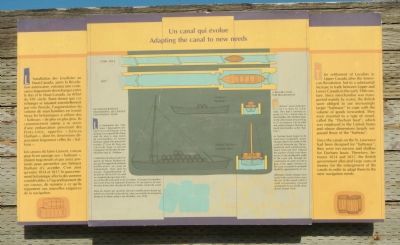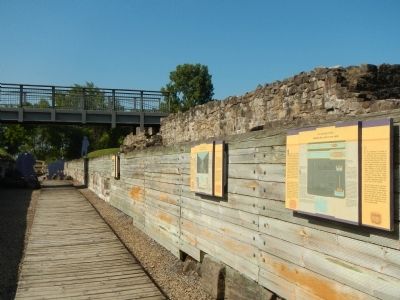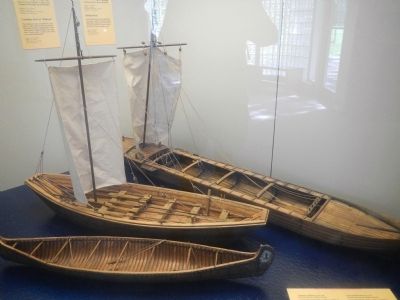Coteau-du-Lac in Vaudreuil-Soulanges, Québec — Central Canada (French-Canadian)
Adapting the canal to new needs
Un canal qui évolue
The settlement of Loyalists in Upper Canada after the American Revolution led to a substantial increase in trade between Upper and Lower Canada in the early 19th century. Since merchandise was transported mainly by water, the British were obliged to use increasingly larger “batteaux” to cope with the volume of goods forwarded. They even resorted to a type of vessel called the “Durham boat”, which was employed in the United States and whose dimensions largely surpassed those of the “batteau(x)”.
Since the canals on the St. Lawrence had been designed for “batteaux”, they were too narrow and shallow for Durham boats. Therfore, between 1814 and 1817, the British government allocated large sums of money for the enlargement of the canals in order to adapt them to the new navigation needs.
A Bigger Canal for Bigger Boats
“Batteaux” were rarely over 12.1 , long by 2.4 m wide. They had a carrying capacity of 3 to 5 metric tons of merchandise. The Durham boat, on the other hand, measured up to 27.4 m long by 3.65 m wide and could transport 10 times as much merchandise as the “batteau(x)”.
As Durham boats began to be used more frequently, major changes has to be made in the canal at Coteau-du-Lac. The enlargement work carried out between 1814 and 1817 reduced the number of locks from three to two. It also doubled the width of the canal and, through the construction of a jetty over 80 m long at the upper entrance to the canal, increased its navigable depth by approximately 45 cm.
Although various changes were made in the canal in later years, the size of the vessels which it could accommodate remained unchanged. It was finally abandoned around 1850.
French:
L’installation des Loyalists au Haut-Canada, après la Révolution américaine, entraîna une croissance importante des échanges entre le Bas et le Haut-Canada, au debut du XIXᵉ siècle. Étant donné que ces échanges se faisaient essentiellement par voie fluviale, l’augmentation du volume de marchandises en transit força les britanniques à utiliser des «batteaux» de plus en plus gros. Ils commencèrent même à se servir d’une embarcation provient des États-Unis, appelée «bateau Durham», dont les dimensions dépassaient largement celles du «batteau».
Les canaux de Saint-Laurent, conçus pour livrer passage aux «batteaux», étaient trop étroits et pas assez profonds pour permettre au bateaux Durham d’y accéder. C’est ainsi qu’entre 1814 et 1817, le gouvernement britannique affecta des sommes considérables à l’agrandissement de ces canaux, de manière à ce qu’ils répondent aux nouvelles exigences de la navigation.
Quand les bateaux grandissent, les canaux grandissent aussi!
Les dimensions des «batteaux» dépassent rarement 12,1 m de long par 2,4 m de large. Leur capacité de charge était de trois à cinq tonnes de marchandises. Le bateau Durham, quant à lui, pouvait atteindre 27,4 m de long par 3,65 m de large et pouvait transporter dix fois plus de marchandises que le «batteau».
L’utilisation de plus en plus fréquente du bateau Durham exigea que l’on apporte de sérieuses modifications au canal de Coteau-du-lac. Ainsi, après les travaux d’agrandissent effectues de 1814 a 1817, le canal ne comptait plus que deux écluses à lieu des trois qu’il avait à l’origine. Sa largeur fut doublée. Son tirant d’eau fut augmenté d’environ 45 cm, grâce à la construction d’une jeter de plus de 80 m à l’entrée amont du canal.
Dans les années qui suivirent, diverses modifications furent apportées au canal Coteau-du-lac, mais son échelle de navigation demeura la même jusqu’a son abandon, vers 1850.
Erected by Parks Canada / Parcs Canada.
Topics. This historical marker is listed in these topic lists: Forts and Castles • War of 1812 • Waterways & Vessels. A significant historical year for this entry is 1814.
Location. 45° 17.262′ N, 74° 10.552′ W. Marker is in Coteau-du-Lac, Québec, in Vaudreuil-Soulanges. Marker can be reached from Chemin du Fleuve close to Rue du Fort, on the left when traveling south. Touch for map. Marker is at or near this postal address: 307 Chemin du Fleuve, Coteau-du-Lac QC J0P 1B0, Canada. Touch for directions.
Other nearby markers. At least 8 other markers are within walking distance of this marker. A canal that must be preserved (here, next to this marker); A very busy canal (a few steps from this marker); What is a lock canal? (a few steps from this marker); Destination: Great Lakes / Destination: Les Grands Lacs (a few steps from this marker); North blockhouse / Le blockhaus nord (a few steps from this marker); A canal excavated in the rock (within shouting distance of this marker); A supply centre / Un poste de ravitaillement (within shouting distance of this marker); The Durham boat (within shouting distance of this marker). Touch for a list and map of all markers in Coteau-du-Lac.
More about this marker. This marker is located at Coteau-du-Lac National Historic Site.
Credits. This page was last revised on June 16, 2016. It was originally submitted on May 28, 2015, by Barry Swackhamer of Brentwood, California. This page has been viewed 334 times since then and 11 times this year. Photos: 1, 2, 3. submitted on May 28, 2015, by Barry Swackhamer of Brentwood, California. • Andrew Ruppenstein was the editor who published this page.


